Organisational Behaviour: Culture, Politics, Power at Procter & Gamble
VerifiedAdded on 2023/06/13
|16
|5218
|393
Report
AI Summary
This report provides a comprehensive case study analysis of organisational behaviour within Procter & Gamble (P&G), focusing on the intricate relationships between culture, politics, power, and motivation. It critically evaluates how these elements influence individual and team behaviour, impacting overall performance and productivity. The report explores various motivational theories, including Maslow's Hierarchy of Needs and Herzberg's Two-Factor Theory, to understand employee needs and enhance motivation. Additionally, it examines process theories such as Expectancy Theory and Goal-Setting Theory to analyse the psychological and behavioural aspects affecting motivation. The study assesses the relevance of team development theories and concepts in improving business performance at P&G and evaluates how concepts and philosophies of organisational behaviour inform and influence actions within the organisation, ultimately aiming to provide justified recommendations for fostering a successful organisational environment.
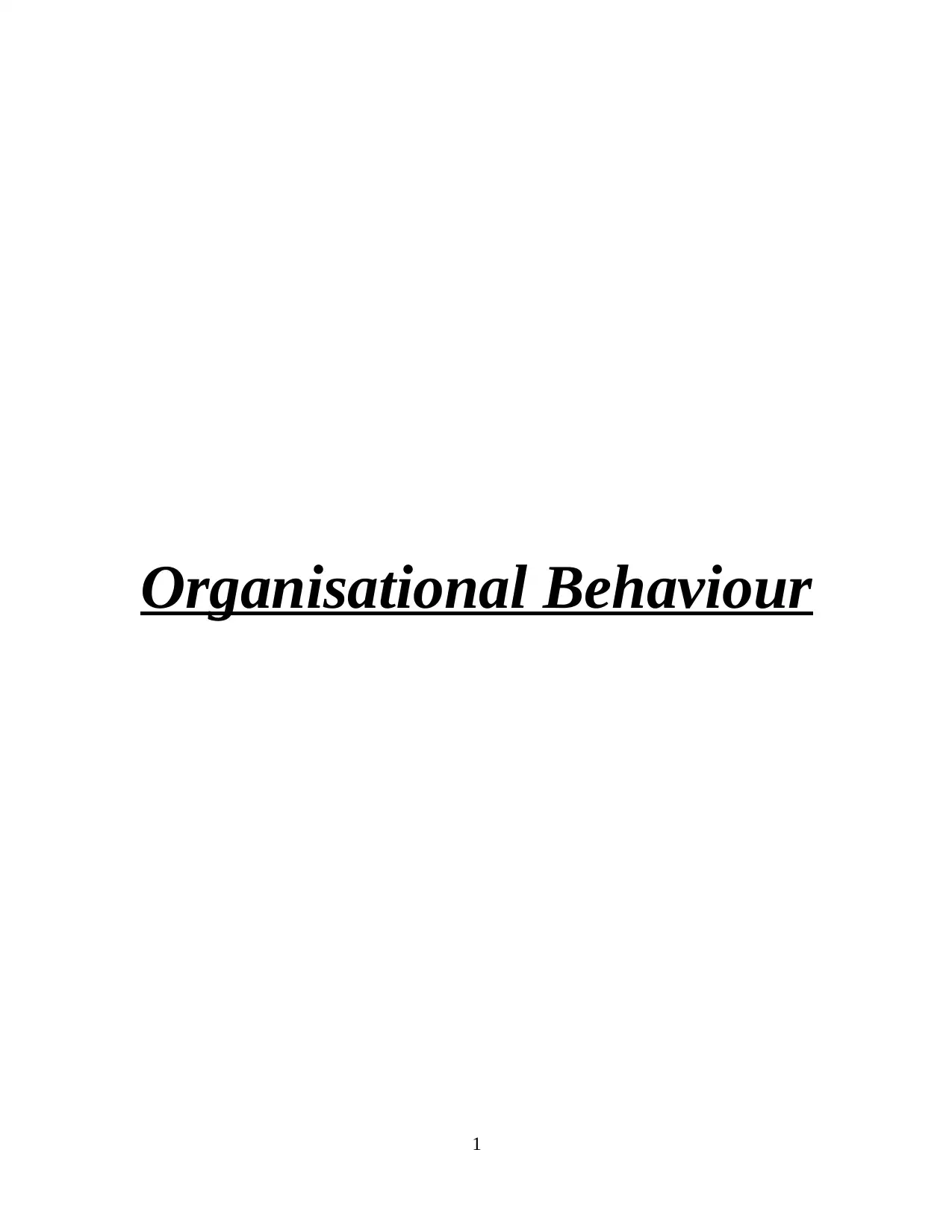
Organisational Behaviour
1
1
Paraphrase This Document
Need a fresh take? Get an instant paraphrase of this document with our AI Paraphraser
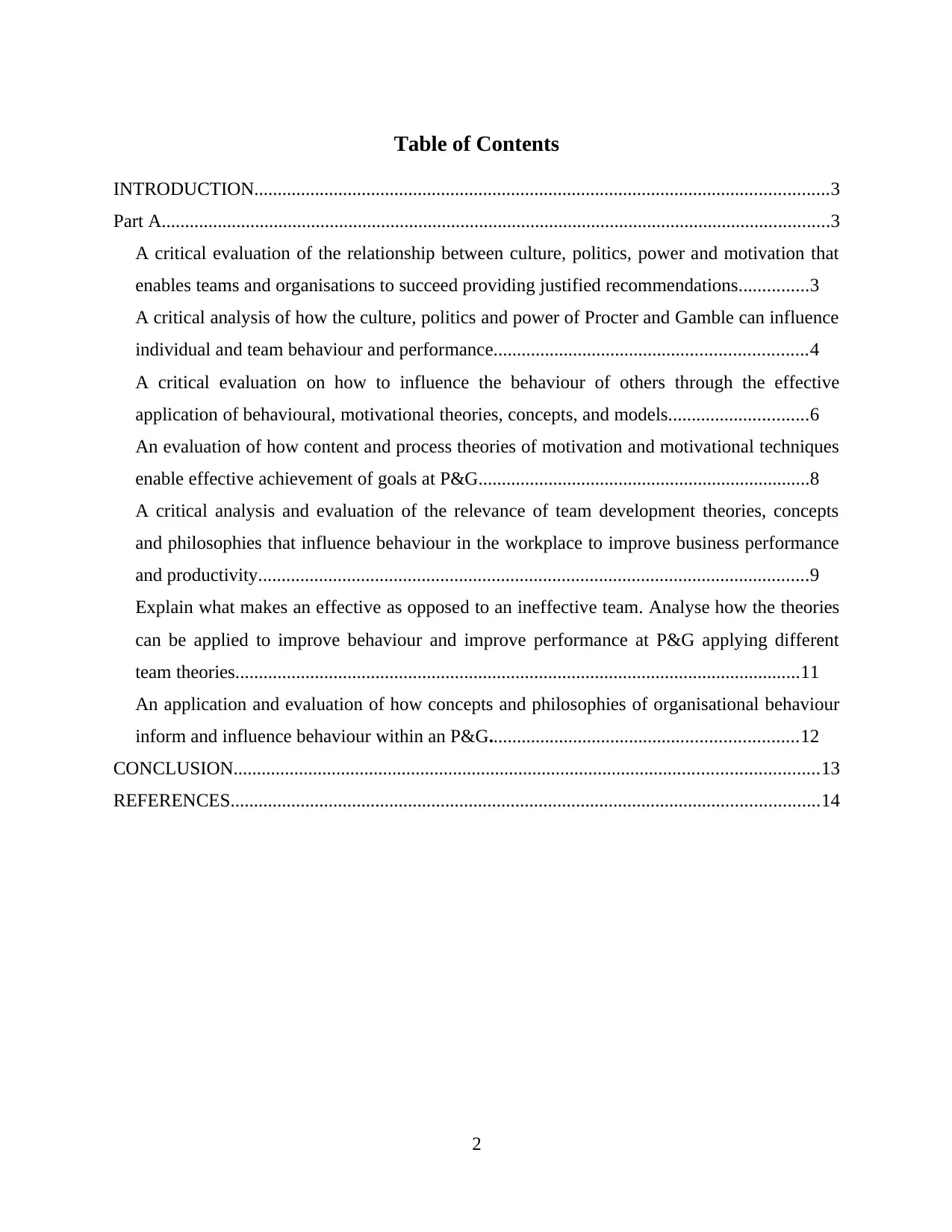
Table of Contents
INTRODUCTION...........................................................................................................................3
Part A...............................................................................................................................................3
A critical evaluation of the relationship between culture, politics, power and motivation that
enables teams and organisations to succeed providing justified recommendations...............3
A critical analysis of how the culture, politics and power of Procter and Gamble can influence
individual and team behaviour and performance...................................................................4
A critical evaluation on how to influence the behaviour of others through the effective
application of behavioural, motivational theories, concepts, and models..............................6
An evaluation of how content and process theories of motivation and motivational techniques
enable effective achievement of goals at P&G.......................................................................8
A critical analysis and evaluation of the relevance of team development theories, concepts
and philosophies that influence behaviour in the workplace to improve business performance
and productivity......................................................................................................................9
Explain what makes an effective as opposed to an ineffective team. Analyse how the theories
can be applied to improve behaviour and improve performance at P&G applying different
team theories.........................................................................................................................11
An application and evaluation of how concepts and philosophies of organisational behaviour
inform and influence behaviour within an P&G..................................................................12
CONCLUSION.............................................................................................................................13
REFERENCES..............................................................................................................................14
2
INTRODUCTION...........................................................................................................................3
Part A...............................................................................................................................................3
A critical evaluation of the relationship between culture, politics, power and motivation that
enables teams and organisations to succeed providing justified recommendations...............3
A critical analysis of how the culture, politics and power of Procter and Gamble can influence
individual and team behaviour and performance...................................................................4
A critical evaluation on how to influence the behaviour of others through the effective
application of behavioural, motivational theories, concepts, and models..............................6
An evaluation of how content and process theories of motivation and motivational techniques
enable effective achievement of goals at P&G.......................................................................8
A critical analysis and evaluation of the relevance of team development theories, concepts
and philosophies that influence behaviour in the workplace to improve business performance
and productivity......................................................................................................................9
Explain what makes an effective as opposed to an ineffective team. Analyse how the theories
can be applied to improve behaviour and improve performance at P&G applying different
team theories.........................................................................................................................11
An application and evaluation of how concepts and philosophies of organisational behaviour
inform and influence behaviour within an P&G..................................................................12
CONCLUSION.............................................................................................................................13
REFERENCES..............................................................................................................................14
2
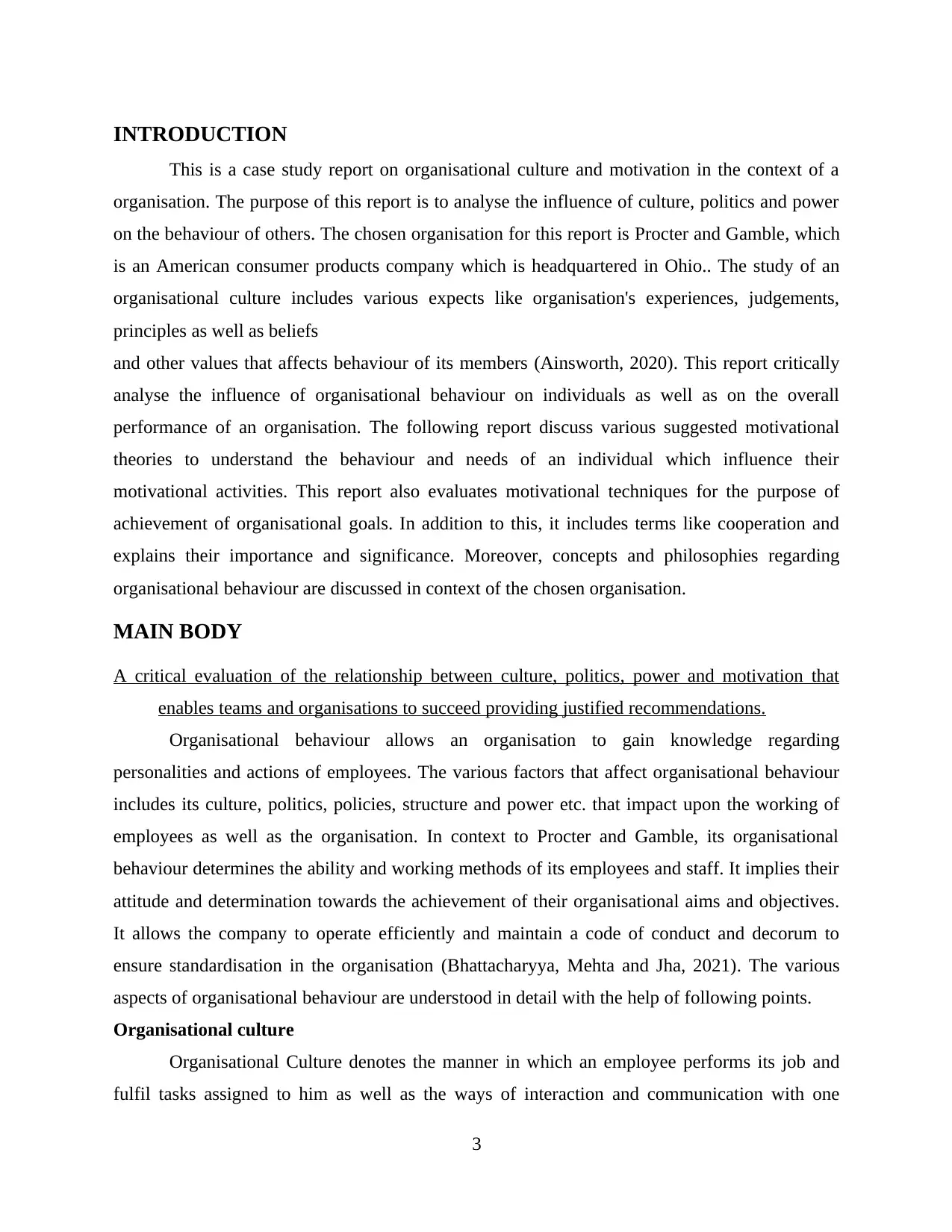
INTRODUCTION
This is a case study report on organisational culture and motivation in the context of a
organisation. The purpose of this report is to analyse the influence of culture, politics and power
on the behaviour of others. The chosen organisation for this report is Procter and Gamble, which
is an American consumer products company which is headquartered in Ohio.. The study of an
organisational culture includes various expects like organisation's experiences, judgements,
principles as well as beliefs
and other values that affects behaviour of its members (Ainsworth, 2020). This report critically
analyse the influence of organisational behaviour on individuals as well as on the overall
performance of an organisation. The following report discuss various suggested motivational
theories to understand the behaviour and needs of an individual which influence their
motivational activities. This report also evaluates motivational techniques for the purpose of
achievement of organisational goals. In addition to this, it includes terms like cooperation and
explains their importance and significance. Moreover, concepts and philosophies regarding
organisational behaviour are discussed in context of the chosen organisation.
MAIN BODY
A critical evaluation of the relationship between culture, politics, power and motivation that
enables teams and organisations to succeed providing justified recommendations.
Organisational behaviour allows an organisation to gain knowledge regarding
personalities and actions of employees. The various factors that affect organisational behaviour
includes its culture, politics, policies, structure and power etc. that impact upon the working of
employees as well as the organisation. In context to Procter and Gamble, its organisational
behaviour determines the ability and working methods of its employees and staff. It implies their
attitude and determination towards the achievement of their organisational aims and objectives.
It allows the company to operate efficiently and maintain a code of conduct and decorum to
ensure standardisation in the organisation (Bhattacharyya, Mehta and Jha, 2021). The various
aspects of organisational behaviour are understood in detail with the help of following points.
Organisational culture
Organisational Culture denotes the manner in which an employee performs its job and
fulfil tasks assigned to him as well as the ways of interaction and communication with one
3
This is a case study report on organisational culture and motivation in the context of a
organisation. The purpose of this report is to analyse the influence of culture, politics and power
on the behaviour of others. The chosen organisation for this report is Procter and Gamble, which
is an American consumer products company which is headquartered in Ohio.. The study of an
organisational culture includes various expects like organisation's experiences, judgements,
principles as well as beliefs
and other values that affects behaviour of its members (Ainsworth, 2020). This report critically
analyse the influence of organisational behaviour on individuals as well as on the overall
performance of an organisation. The following report discuss various suggested motivational
theories to understand the behaviour and needs of an individual which influence their
motivational activities. This report also evaluates motivational techniques for the purpose of
achievement of organisational goals. In addition to this, it includes terms like cooperation and
explains their importance and significance. Moreover, concepts and philosophies regarding
organisational behaviour are discussed in context of the chosen organisation.
MAIN BODY
A critical evaluation of the relationship between culture, politics, power and motivation that
enables teams and organisations to succeed providing justified recommendations.
Organisational behaviour allows an organisation to gain knowledge regarding
personalities and actions of employees. The various factors that affect organisational behaviour
includes its culture, politics, policies, structure and power etc. that impact upon the working of
employees as well as the organisation. In context to Procter and Gamble, its organisational
behaviour determines the ability and working methods of its employees and staff. It implies their
attitude and determination towards the achievement of their organisational aims and objectives.
It allows the company to operate efficiently and maintain a code of conduct and decorum to
ensure standardisation in the organisation (Bhattacharyya, Mehta and Jha, 2021). The various
aspects of organisational behaviour are understood in detail with the help of following points.
Organisational culture
Organisational Culture denotes the manner in which an employee performs its job and
fulfil tasks assigned to him as well as the ways of interaction and communication with one
3
⊘ This is a preview!⊘
Do you want full access?
Subscribe today to unlock all pages.

Trusted by 1+ million students worldwide
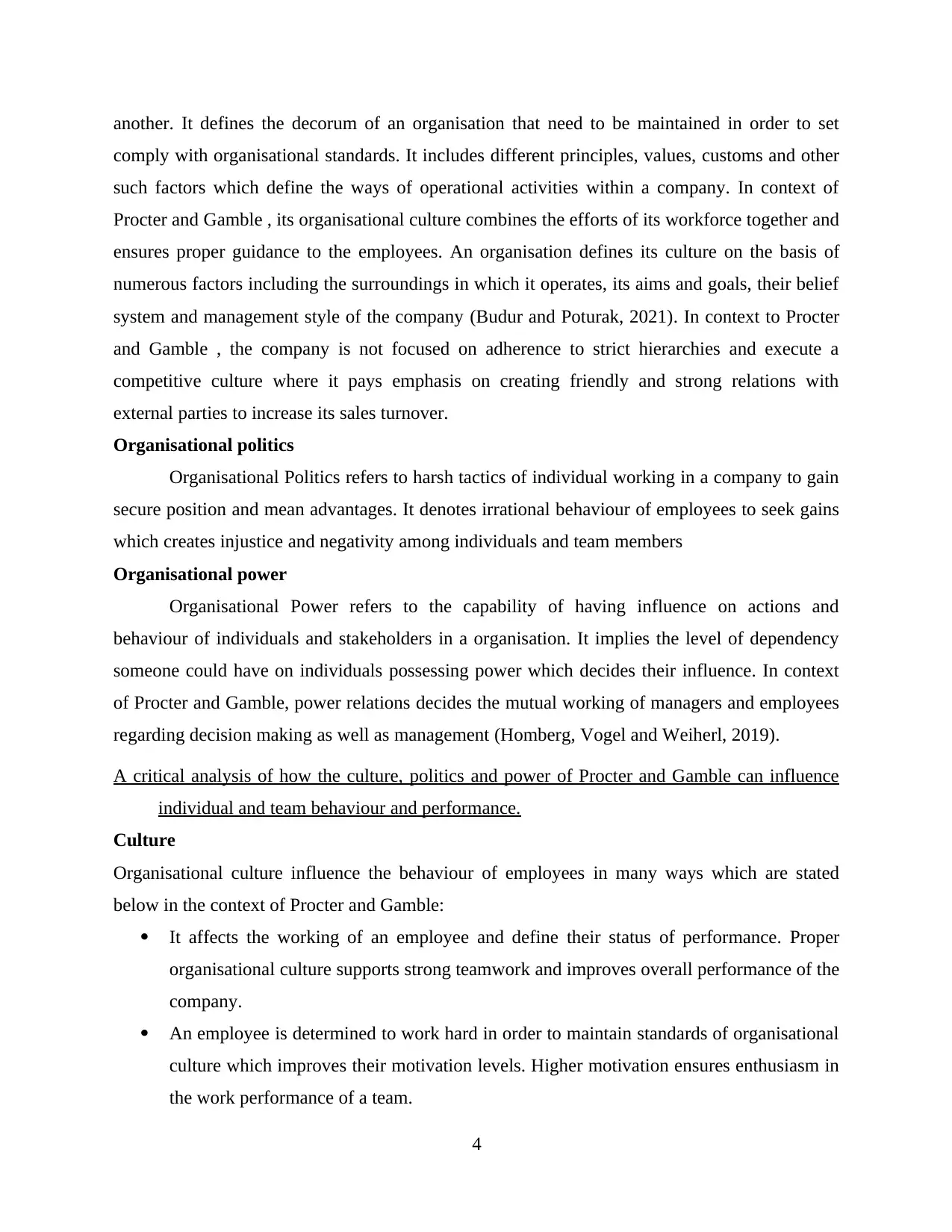
another. It defines the decorum of an organisation that need to be maintained in order to set
comply with organisational standards. It includes different principles, values, customs and other
such factors which define the ways of operational activities within a company. In context of
Procter and Gamble , its organisational culture combines the efforts of its workforce together and
ensures proper guidance to the employees. An organisation defines its culture on the basis of
numerous factors including the surroundings in which it operates, its aims and goals, their belief
system and management style of the company (Budur and Poturak, 2021). In context to Procter
and Gamble , the company is not focused on adherence to strict hierarchies and execute a
competitive culture where it pays emphasis on creating friendly and strong relations with
external parties to increase its sales turnover.
Organisational politics
Organisational Politics refers to harsh tactics of individual working in a company to gain
secure position and mean advantages. It denotes irrational behaviour of employees to seek gains
which creates injustice and negativity among individuals and team members
Organisational power
Organisational Power refers to the capability of having influence on actions and
behaviour of individuals and stakeholders in a organisation. It implies the level of dependency
someone could have on individuals possessing power which decides their influence. In context
of Procter and Gamble, power relations decides the mutual working of managers and employees
regarding decision making as well as management (Homberg, Vogel and Weiherl, 2019).
A critical analysis of how the culture, politics and power of Procter and Gamble can influence
individual and team behaviour and performance.
Culture
Organisational culture influence the behaviour of employees in many ways which are stated
below in the context of Procter and Gamble:
It affects the working of an employee and define their status of performance. Proper
organisational culture supports strong teamwork and improves overall performance of the
company.
An employee is determined to work hard in order to maintain standards of organisational
culture which improves their motivation levels. Higher motivation ensures enthusiasm in
the work performance of a team.
4
comply with organisational standards. It includes different principles, values, customs and other
such factors which define the ways of operational activities within a company. In context of
Procter and Gamble , its organisational culture combines the efforts of its workforce together and
ensures proper guidance to the employees. An organisation defines its culture on the basis of
numerous factors including the surroundings in which it operates, its aims and goals, their belief
system and management style of the company (Budur and Poturak, 2021). In context to Procter
and Gamble , the company is not focused on adherence to strict hierarchies and execute a
competitive culture where it pays emphasis on creating friendly and strong relations with
external parties to increase its sales turnover.
Organisational politics
Organisational Politics refers to harsh tactics of individual working in a company to gain
secure position and mean advantages. It denotes irrational behaviour of employees to seek gains
which creates injustice and negativity among individuals and team members
Organisational power
Organisational Power refers to the capability of having influence on actions and
behaviour of individuals and stakeholders in a organisation. It implies the level of dependency
someone could have on individuals possessing power which decides their influence. In context
of Procter and Gamble, power relations decides the mutual working of managers and employees
regarding decision making as well as management (Homberg, Vogel and Weiherl, 2019).
A critical analysis of how the culture, politics and power of Procter and Gamble can influence
individual and team behaviour and performance.
Culture
Organisational culture influence the behaviour of employees in many ways which are stated
below in the context of Procter and Gamble:
It affects the working of an employee and define their status of performance. Proper
organisational culture supports strong teamwork and improves overall performance of the
company.
An employee is determined to work hard in order to maintain standards of organisational
culture which improves their motivation levels. Higher motivation ensures enthusiasm in
the work performance of a team.
4
Paraphrase This Document
Need a fresh take? Get an instant paraphrase of this document with our AI Paraphraser
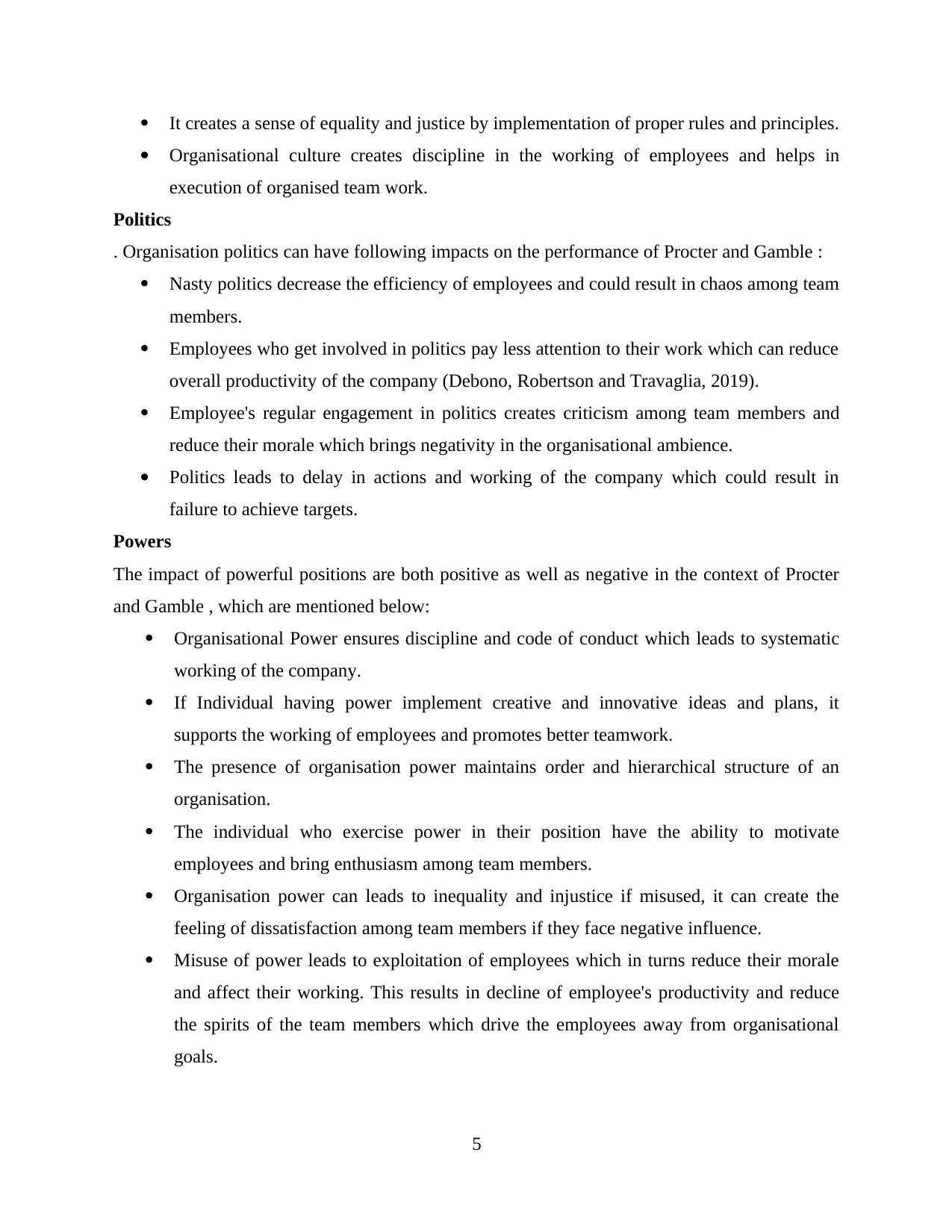
It creates a sense of equality and justice by implementation of proper rules and principles.
Organisational culture creates discipline in the working of employees and helps in
execution of organised team work.
Politics
. Organisation politics can have following impacts on the performance of Procter and Gamble :
Nasty politics decrease the efficiency of employees and could result in chaos among team
members.
Employees who get involved in politics pay less attention to their work which can reduce
overall productivity of the company (Debono, Robertson and Travaglia, 2019).
Employee's regular engagement in politics creates criticism among team members and
reduce their morale which brings negativity in the organisational ambience.
Politics leads to delay in actions and working of the company which could result in
failure to achieve targets.
Powers
The impact of powerful positions are both positive as well as negative in the context of Procter
and Gamble , which are mentioned below:
Organisational Power ensures discipline and code of conduct which leads to systematic
working of the company.
If Individual having power implement creative and innovative ideas and plans, it
supports the working of employees and promotes better teamwork.
The presence of organisation power maintains order and hierarchical structure of an
organisation.
The individual who exercise power in their position have the ability to motivate
employees and bring enthusiasm among team members.
Organisation power can leads to inequality and injustice if misused, it can create the
feeling of dissatisfaction among team members if they face negative influence.
Misuse of power leads to exploitation of employees which in turns reduce their morale
and affect their working. This results in decline of employee's productivity and reduce
the spirits of the team members which drive the employees away from organisational
goals.
5
Organisational culture creates discipline in the working of employees and helps in
execution of organised team work.
Politics
. Organisation politics can have following impacts on the performance of Procter and Gamble :
Nasty politics decrease the efficiency of employees and could result in chaos among team
members.
Employees who get involved in politics pay less attention to their work which can reduce
overall productivity of the company (Debono, Robertson and Travaglia, 2019).
Employee's regular engagement in politics creates criticism among team members and
reduce their morale which brings negativity in the organisational ambience.
Politics leads to delay in actions and working of the company which could result in
failure to achieve targets.
Powers
The impact of powerful positions are both positive as well as negative in the context of Procter
and Gamble , which are mentioned below:
Organisational Power ensures discipline and code of conduct which leads to systematic
working of the company.
If Individual having power implement creative and innovative ideas and plans, it
supports the working of employees and promotes better teamwork.
The presence of organisation power maintains order and hierarchical structure of an
organisation.
The individual who exercise power in their position have the ability to motivate
employees and bring enthusiasm among team members.
Organisation power can leads to inequality and injustice if misused, it can create the
feeling of dissatisfaction among team members if they face negative influence.
Misuse of power leads to exploitation of employees which in turns reduce their morale
and affect their working. This results in decline of employee's productivity and reduce
the spirits of the team members which drive the employees away from organisational
goals.
5
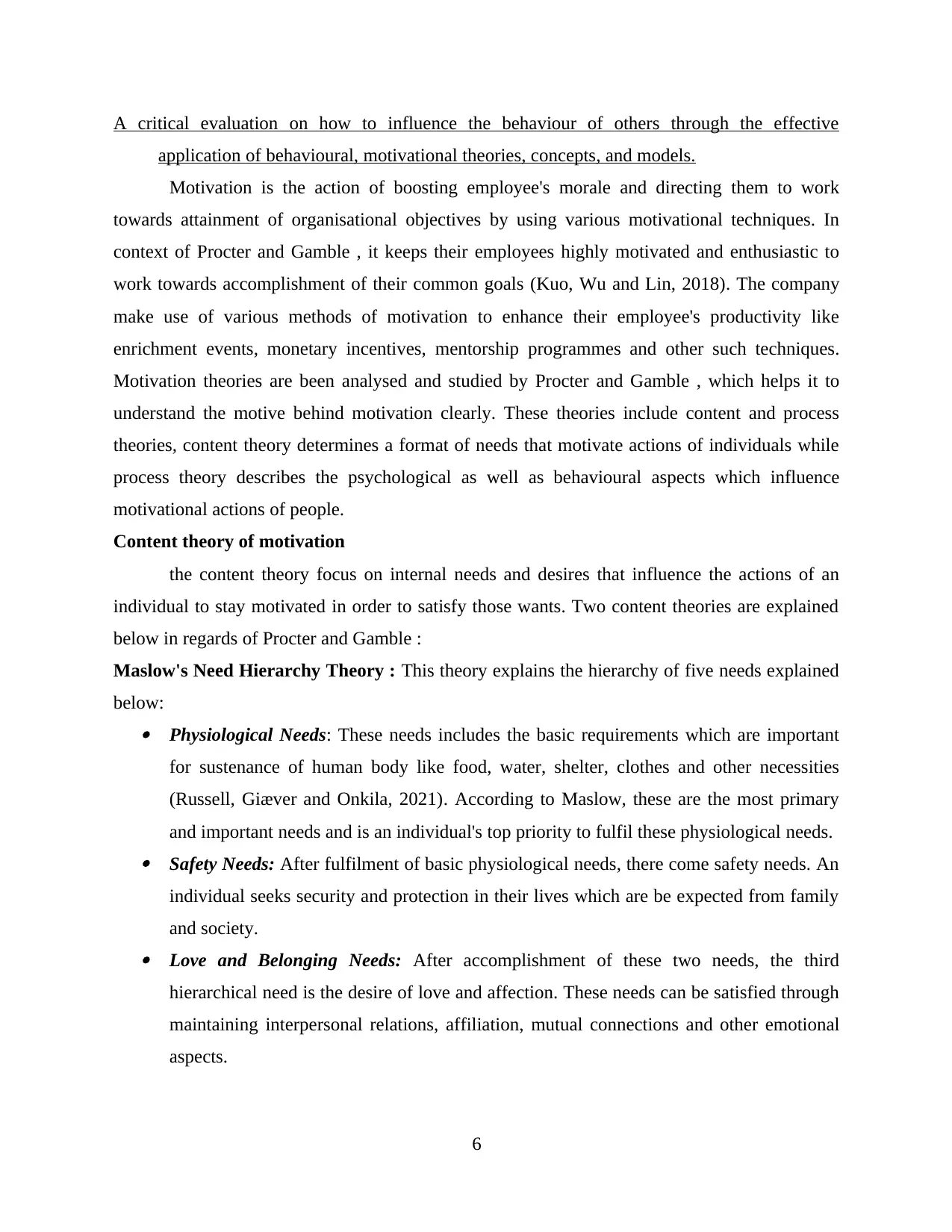
A critical evaluation on how to influence the behaviour of others through the effective
application of behavioural, motivational theories, concepts, and models.
Motivation is the action of boosting employee's morale and directing them to work
towards attainment of organisational objectives by using various motivational techniques. In
context of Procter and Gamble , it keeps their employees highly motivated and enthusiastic to
work towards accomplishment of their common goals (Kuo, Wu and Lin, 2018). The company
make use of various methods of motivation to enhance their employee's productivity like
enrichment events, monetary incentives, mentorship programmes and other such techniques.
Motivation theories are been analysed and studied by Procter and Gamble , which helps it to
understand the motive behind motivation clearly. These theories include content and process
theories, content theory determines a format of needs that motivate actions of individuals while
process theory describes the psychological as well as behavioural aspects which influence
motivational actions of people.
Content theory of motivation
the content theory focus on internal needs and desires that influence the actions of an
individual to stay motivated in order to satisfy those wants. Two content theories are explained
below in regards of Procter and Gamble :
Maslow's Need Hierarchy Theory : This theory explains the hierarchy of five needs explained
below: Physiological Needs: These needs includes the basic requirements which are important
for sustenance of human body like food, water, shelter, clothes and other necessities
(Russell, Giæver and Onkila, 2021). According to Maslow, these are the most primary
and important needs and is an individual's top priority to fulfil these physiological needs. Safety Needs: After fulfilment of basic physiological needs, there come safety needs. An
individual seeks security and protection in their lives which are be expected from family
and society. Love and Belonging Needs: After accomplishment of these two needs, the third
hierarchical need is the desire of love and affection. These needs can be satisfied through
maintaining interpersonal relations, affiliation, mutual connections and other emotional
aspects.
6
application of behavioural, motivational theories, concepts, and models.
Motivation is the action of boosting employee's morale and directing them to work
towards attainment of organisational objectives by using various motivational techniques. In
context of Procter and Gamble , it keeps their employees highly motivated and enthusiastic to
work towards accomplishment of their common goals (Kuo, Wu and Lin, 2018). The company
make use of various methods of motivation to enhance their employee's productivity like
enrichment events, monetary incentives, mentorship programmes and other such techniques.
Motivation theories are been analysed and studied by Procter and Gamble , which helps it to
understand the motive behind motivation clearly. These theories include content and process
theories, content theory determines a format of needs that motivate actions of individuals while
process theory describes the psychological as well as behavioural aspects which influence
motivational actions of people.
Content theory of motivation
the content theory focus on internal needs and desires that influence the actions of an
individual to stay motivated in order to satisfy those wants. Two content theories are explained
below in regards of Procter and Gamble :
Maslow's Need Hierarchy Theory : This theory explains the hierarchy of five needs explained
below: Physiological Needs: These needs includes the basic requirements which are important
for sustenance of human body like food, water, shelter, clothes and other necessities
(Russell, Giæver and Onkila, 2021). According to Maslow, these are the most primary
and important needs and is an individual's top priority to fulfil these physiological needs. Safety Needs: After fulfilment of basic physiological needs, there come safety needs. An
individual seeks security and protection in their lives which are be expected from family
and society. Love and Belonging Needs: After accomplishment of these two needs, the third
hierarchical need is the desire of love and affection. These needs can be satisfied through
maintaining interpersonal relations, affiliation, mutual connections and other emotional
aspects.
6
⊘ This is a preview!⊘
Do you want full access?
Subscribe today to unlock all pages.

Trusted by 1+ million students worldwide
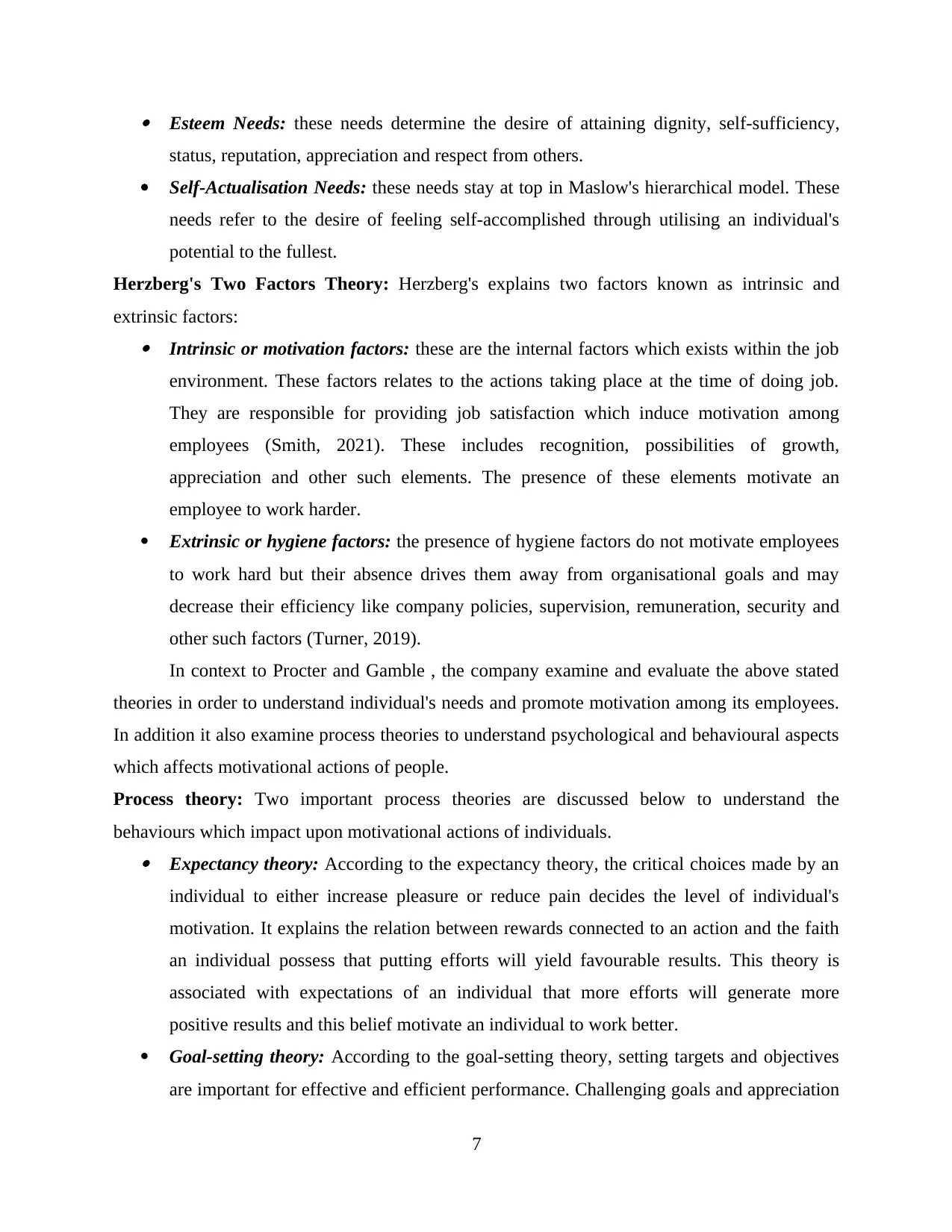
Esteem Needs: these needs determine the desire of attaining dignity, self-sufficiency,
status, reputation, appreciation and respect from others.
Self-Actualisation Needs: these needs stay at top in Maslow's hierarchical model. These
needs refer to the desire of feeling self-accomplished through utilising an individual's
potential to the fullest.
Herzberg's Two Factors Theory: Herzberg's explains two factors known as intrinsic and
extrinsic factors: Intrinsic or motivation factors: these are the internal factors which exists within the job
environment. These factors relates to the actions taking place at the time of doing job.
They are responsible for providing job satisfaction which induce motivation among
employees (Smith, 2021). These includes recognition, possibilities of growth,
appreciation and other such elements. The presence of these elements motivate an
employee to work harder.
Extrinsic or hygiene factors: the presence of hygiene factors do not motivate employees
to work hard but their absence drives them away from organisational goals and may
decrease their efficiency like company policies, supervision, remuneration, security and
other such factors (Turner, 2019).
In context to Procter and Gamble , the company examine and evaluate the above stated
theories in order to understand individual's needs and promote motivation among its employees.
In addition it also examine process theories to understand psychological and behavioural aspects
which affects motivational actions of people.
Process theory: Two important process theories are discussed below to understand the
behaviours which impact upon motivational actions of individuals. Expectancy theory: According to the expectancy theory, the critical choices made by an
individual to either increase pleasure or reduce pain decides the level of individual's
motivation. It explains the relation between rewards connected to an action and the faith
an individual possess that putting efforts will yield favourable results. This theory is
associated with expectations of an individual that more efforts will generate more
positive results and this belief motivate an individual to work better.
Goal-setting theory: According to the goal-setting theory, setting targets and objectives
are important for effective and efficient performance. Challenging goals and appreciation
7
status, reputation, appreciation and respect from others.
Self-Actualisation Needs: these needs stay at top in Maslow's hierarchical model. These
needs refer to the desire of feeling self-accomplished through utilising an individual's
potential to the fullest.
Herzberg's Two Factors Theory: Herzberg's explains two factors known as intrinsic and
extrinsic factors: Intrinsic or motivation factors: these are the internal factors which exists within the job
environment. These factors relates to the actions taking place at the time of doing job.
They are responsible for providing job satisfaction which induce motivation among
employees (Smith, 2021). These includes recognition, possibilities of growth,
appreciation and other such elements. The presence of these elements motivate an
employee to work harder.
Extrinsic or hygiene factors: the presence of hygiene factors do not motivate employees
to work hard but their absence drives them away from organisational goals and may
decrease their efficiency like company policies, supervision, remuneration, security and
other such factors (Turner, 2019).
In context to Procter and Gamble , the company examine and evaluate the above stated
theories in order to understand individual's needs and promote motivation among its employees.
In addition it also examine process theories to understand psychological and behavioural aspects
which affects motivational actions of people.
Process theory: Two important process theories are discussed below to understand the
behaviours which impact upon motivational actions of individuals. Expectancy theory: According to the expectancy theory, the critical choices made by an
individual to either increase pleasure or reduce pain decides the level of individual's
motivation. It explains the relation between rewards connected to an action and the faith
an individual possess that putting efforts will yield favourable results. This theory is
associated with expectations of an individual that more efforts will generate more
positive results and this belief motivate an individual to work better.
Goal-setting theory: According to the goal-setting theory, setting targets and objectives
are important for effective and efficient performance. Challenging goals and appreciation
7
Paraphrase This Document
Need a fresh take? Get an instant paraphrase of this document with our AI Paraphraser
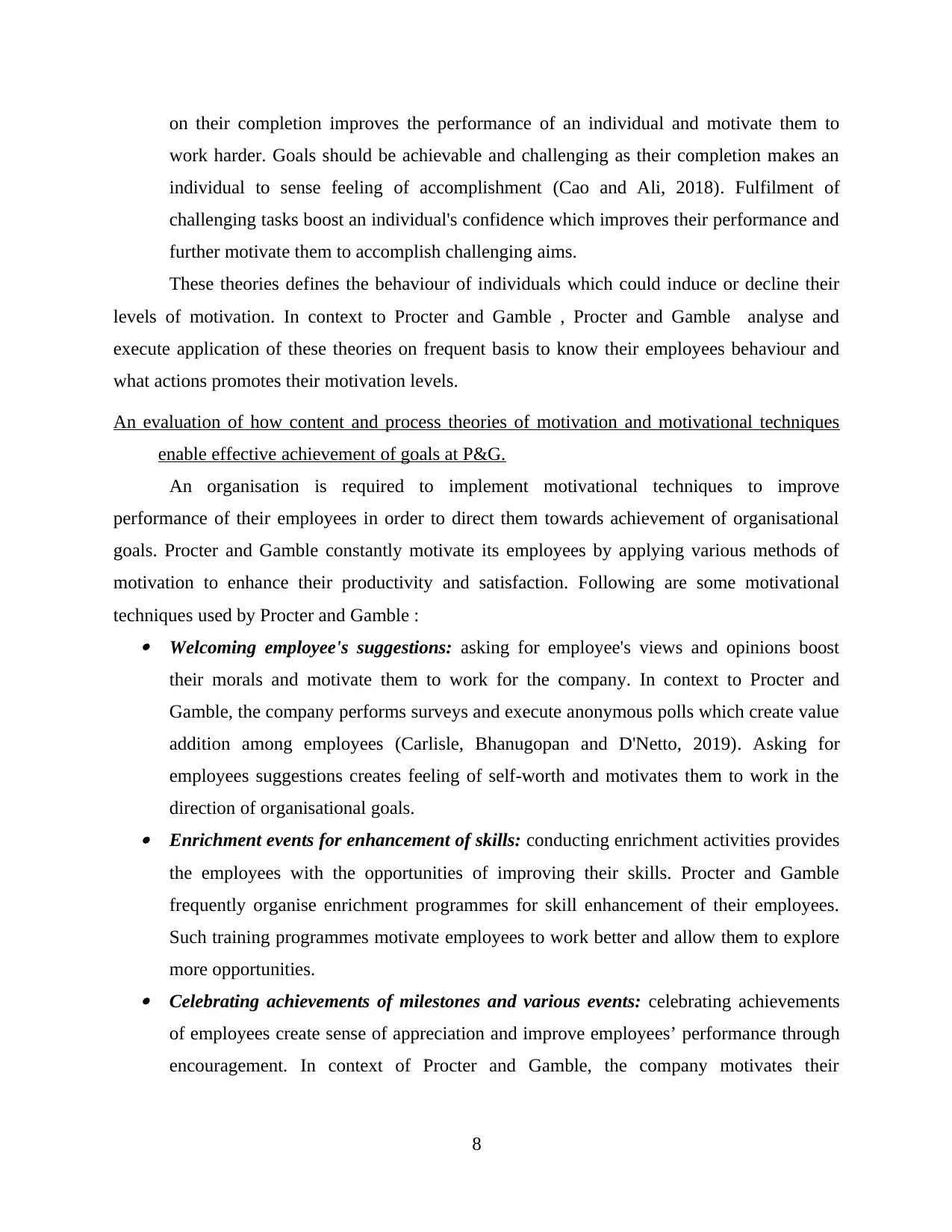
on their completion improves the performance of an individual and motivate them to
work harder. Goals should be achievable and challenging as their completion makes an
individual to sense feeling of accomplishment (Cao and Ali, 2018). Fulfilment of
challenging tasks boost an individual's confidence which improves their performance and
further motivate them to accomplish challenging aims.
These theories defines the behaviour of individuals which could induce or decline their
levels of motivation. In context to Procter and Gamble , Procter and Gamble analyse and
execute application of these theories on frequent basis to know their employees behaviour and
what actions promotes their motivation levels.
An evaluation of how content and process theories of motivation and motivational techniques
enable effective achievement of goals at P&G.
An organisation is required to implement motivational techniques to improve
performance of their employees in order to direct them towards achievement of organisational
goals. Procter and Gamble constantly motivate its employees by applying various methods of
motivation to enhance their productivity and satisfaction. Following are some motivational
techniques used by Procter and Gamble : Welcoming employee's suggestions: asking for employee's views and opinions boost
their morals and motivate them to work for the company. In context to Procter and
Gamble, the company performs surveys and execute anonymous polls which create value
addition among employees (Carlisle, Bhanugopan and D'Netto, 2019). Asking for
employees suggestions creates feeling of self-worth and motivates them to work in the
direction of organisational goals. Enrichment events for enhancement of skills: conducting enrichment activities provides
the employees with the opportunities of improving their skills. Procter and Gamble
frequently organise enrichment programmes for skill enhancement of their employees.
Such training programmes motivate employees to work better and allow them to explore
more opportunities. Celebrating achievements of milestones and various events: celebrating achievements
of employees create sense of appreciation and improve employees’ performance through
encouragement. In context of Procter and Gamble, the company motivates their
8
work harder. Goals should be achievable and challenging as their completion makes an
individual to sense feeling of accomplishment (Cao and Ali, 2018). Fulfilment of
challenging tasks boost an individual's confidence which improves their performance and
further motivate them to accomplish challenging aims.
These theories defines the behaviour of individuals which could induce or decline their
levels of motivation. In context to Procter and Gamble , Procter and Gamble analyse and
execute application of these theories on frequent basis to know their employees behaviour and
what actions promotes their motivation levels.
An evaluation of how content and process theories of motivation and motivational techniques
enable effective achievement of goals at P&G.
An organisation is required to implement motivational techniques to improve
performance of their employees in order to direct them towards achievement of organisational
goals. Procter and Gamble constantly motivate its employees by applying various methods of
motivation to enhance their productivity and satisfaction. Following are some motivational
techniques used by Procter and Gamble : Welcoming employee's suggestions: asking for employee's views and opinions boost
their morals and motivate them to work for the company. In context to Procter and
Gamble, the company performs surveys and execute anonymous polls which create value
addition among employees (Carlisle, Bhanugopan and D'Netto, 2019). Asking for
employees suggestions creates feeling of self-worth and motivates them to work in the
direction of organisational goals. Enrichment events for enhancement of skills: conducting enrichment activities provides
the employees with the opportunities of improving their skills. Procter and Gamble
frequently organise enrichment programmes for skill enhancement of their employees.
Such training programmes motivate employees to work better and allow them to explore
more opportunities. Celebrating achievements of milestones and various events: celebrating achievements
of employees create sense of appreciation and improve employees’ performance through
encouragement. In context of Procter and Gamble, the company motivates their
8
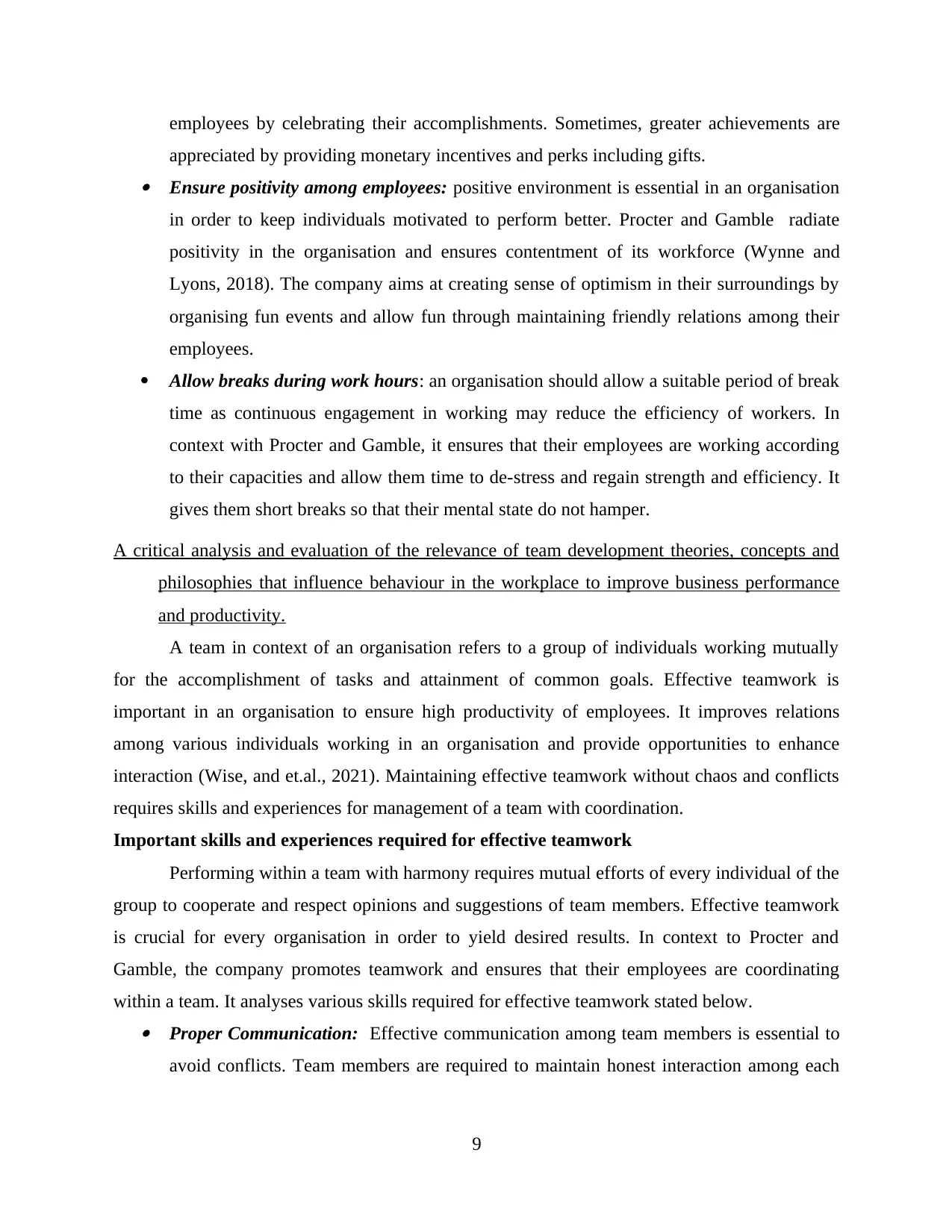
employees by celebrating their accomplishments. Sometimes, greater achievements are
appreciated by providing monetary incentives and perks including gifts. Ensure positivity among employees: positive environment is essential in an organisation
in order to keep individuals motivated to perform better. Procter and Gamble radiate
positivity in the organisation and ensures contentment of its workforce (Wynne and
Lyons, 2018). The company aims at creating sense of optimism in their surroundings by
organising fun events and allow fun through maintaining friendly relations among their
employees.
Allow breaks during work hours: an organisation should allow a suitable period of break
time as continuous engagement in working may reduce the efficiency of workers. In
context with Procter and Gamble, it ensures that their employees are working according
to their capacities and allow them time to de-stress and regain strength and efficiency. It
gives them short breaks so that their mental state do not hamper.
A critical analysis and evaluation of the relevance of team development theories, concepts and
philosophies that influence behaviour in the workplace to improve business performance
and productivity.
A team in context of an organisation refers to a group of individuals working mutually
for the accomplishment of tasks and attainment of common goals. Effective teamwork is
important in an organisation to ensure high productivity of employees. It improves relations
among various individuals working in an organisation and provide opportunities to enhance
interaction (Wise, and et.al., 2021). Maintaining effective teamwork without chaos and conflicts
requires skills and experiences for management of a team with coordination.
Important skills and experiences required for effective teamwork
Performing within a team with harmony requires mutual efforts of every individual of the
group to cooperate and respect opinions and suggestions of team members. Effective teamwork
is crucial for every organisation in order to yield desired results. In context to Procter and
Gamble, the company promotes teamwork and ensures that their employees are coordinating
within a team. It analyses various skills required for effective teamwork stated below. Proper Communication: Effective communication among team members is essential to
avoid conflicts. Team members are required to maintain honest interaction among each
9
appreciated by providing monetary incentives and perks including gifts. Ensure positivity among employees: positive environment is essential in an organisation
in order to keep individuals motivated to perform better. Procter and Gamble radiate
positivity in the organisation and ensures contentment of its workforce (Wynne and
Lyons, 2018). The company aims at creating sense of optimism in their surroundings by
organising fun events and allow fun through maintaining friendly relations among their
employees.
Allow breaks during work hours: an organisation should allow a suitable period of break
time as continuous engagement in working may reduce the efficiency of workers. In
context with Procter and Gamble, it ensures that their employees are working according
to their capacities and allow them time to de-stress and regain strength and efficiency. It
gives them short breaks so that their mental state do not hamper.
A critical analysis and evaluation of the relevance of team development theories, concepts and
philosophies that influence behaviour in the workplace to improve business performance
and productivity.
A team in context of an organisation refers to a group of individuals working mutually
for the accomplishment of tasks and attainment of common goals. Effective teamwork is
important in an organisation to ensure high productivity of employees. It improves relations
among various individuals working in an organisation and provide opportunities to enhance
interaction (Wise, and et.al., 2021). Maintaining effective teamwork without chaos and conflicts
requires skills and experiences for management of a team with coordination.
Important skills and experiences required for effective teamwork
Performing within a team with harmony requires mutual efforts of every individual of the
group to cooperate and respect opinions and suggestions of team members. Effective teamwork
is crucial for every organisation in order to yield desired results. In context to Procter and
Gamble, the company promotes teamwork and ensures that their employees are coordinating
within a team. It analyses various skills required for effective teamwork stated below. Proper Communication: Effective communication among team members is essential to
avoid conflicts. Team members are required to maintain honest interaction among each
9
⊘ This is a preview!⊘
Do you want full access?
Subscribe today to unlock all pages.

Trusted by 1+ million students worldwide
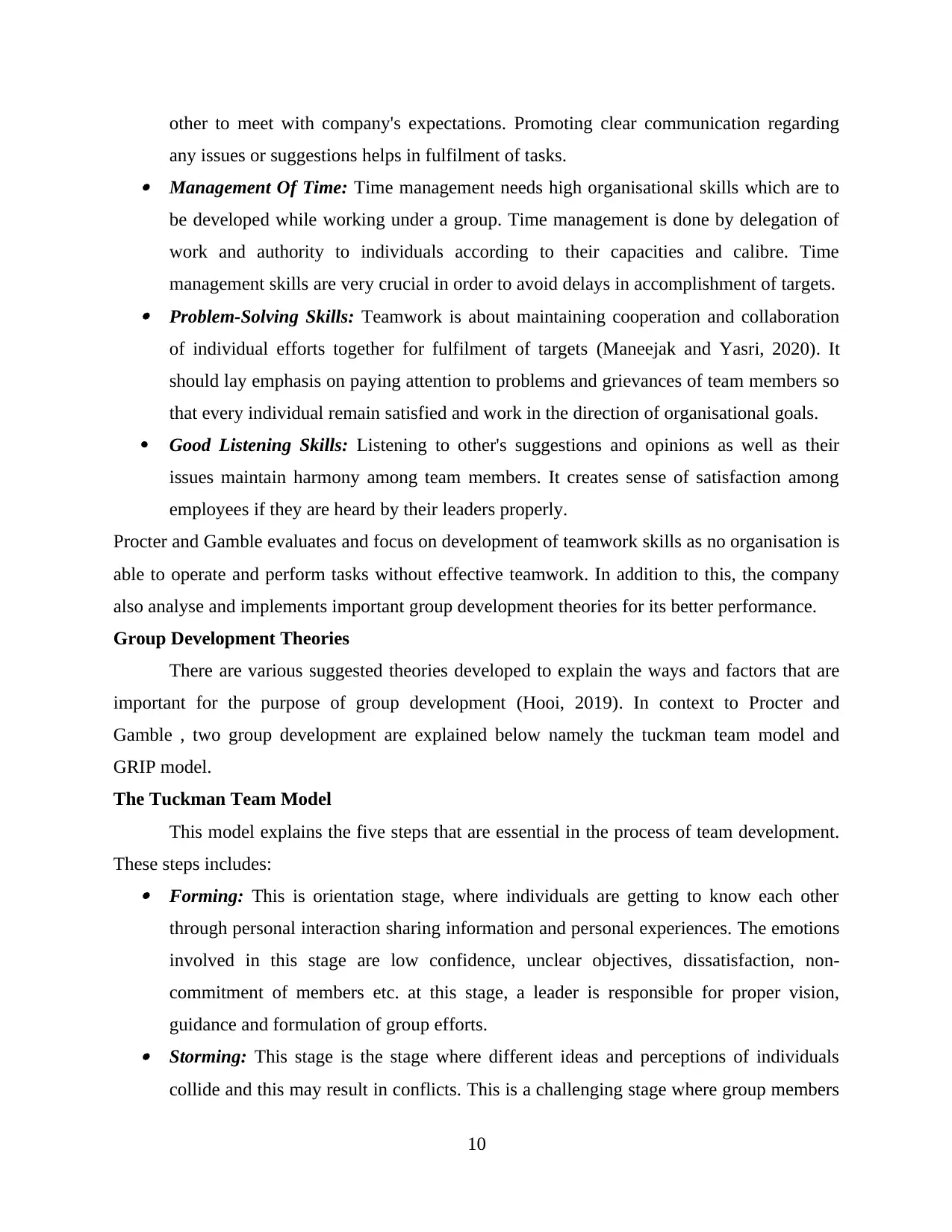
other to meet with company's expectations. Promoting clear communication regarding
any issues or suggestions helps in fulfilment of tasks. Management Of Time: Time management needs high organisational skills which are to
be developed while working under a group. Time management is done by delegation of
work and authority to individuals according to their capacities and calibre. Time
management skills are very crucial in order to avoid delays in accomplishment of targets. Problem-Solving Skills: Teamwork is about maintaining cooperation and collaboration
of individual efforts together for fulfilment of targets (Maneejak and Yasri, 2020). It
should lay emphasis on paying attention to problems and grievances of team members so
that every individual remain satisfied and work in the direction of organisational goals.
Good Listening Skills: Listening to other's suggestions and opinions as well as their
issues maintain harmony among team members. It creates sense of satisfaction among
employees if they are heard by their leaders properly.
Procter and Gamble evaluates and focus on development of teamwork skills as no organisation is
able to operate and perform tasks without effective teamwork. In addition to this, the company
also analyse and implements important group development theories for its better performance.
Group Development Theories
There are various suggested theories developed to explain the ways and factors that are
important for the purpose of group development (Hooi, 2019). In context to Procter and
Gamble , two group development are explained below namely the tuckman team model and
GRIP model.
The Tuckman Team Model
This model explains the five steps that are essential in the process of team development.
These steps includes: Forming: This is orientation stage, where individuals are getting to know each other
through personal interaction sharing information and personal experiences. The emotions
involved in this stage are low confidence, unclear objectives, dissatisfaction, non-
commitment of members etc. at this stage, a leader is responsible for proper vision,
guidance and formulation of group efforts. Storming: This stage is the stage where different ideas and perceptions of individuals
collide and this may result in conflicts. This is a challenging stage where group members
10
any issues or suggestions helps in fulfilment of tasks. Management Of Time: Time management needs high organisational skills which are to
be developed while working under a group. Time management is done by delegation of
work and authority to individuals according to their capacities and calibre. Time
management skills are very crucial in order to avoid delays in accomplishment of targets. Problem-Solving Skills: Teamwork is about maintaining cooperation and collaboration
of individual efforts together for fulfilment of targets (Maneejak and Yasri, 2020). It
should lay emphasis on paying attention to problems and grievances of team members so
that every individual remain satisfied and work in the direction of organisational goals.
Good Listening Skills: Listening to other's suggestions and opinions as well as their
issues maintain harmony among team members. It creates sense of satisfaction among
employees if they are heard by their leaders properly.
Procter and Gamble evaluates and focus on development of teamwork skills as no organisation is
able to operate and perform tasks without effective teamwork. In addition to this, the company
also analyse and implements important group development theories for its better performance.
Group Development Theories
There are various suggested theories developed to explain the ways and factors that are
important for the purpose of group development (Hooi, 2019). In context to Procter and
Gamble , two group development are explained below namely the tuckman team model and
GRIP model.
The Tuckman Team Model
This model explains the five steps that are essential in the process of team development.
These steps includes: Forming: This is orientation stage, where individuals are getting to know each other
through personal interaction sharing information and personal experiences. The emotions
involved in this stage are low confidence, unclear objectives, dissatisfaction, non-
commitment of members etc. at this stage, a leader is responsible for proper vision,
guidance and formulation of group efforts. Storming: This stage is the stage where different ideas and perceptions of individuals
collide and this may result in conflicts. This is a challenging stage where group members
10
Paraphrase This Document
Need a fresh take? Get an instant paraphrase of this document with our AI Paraphraser
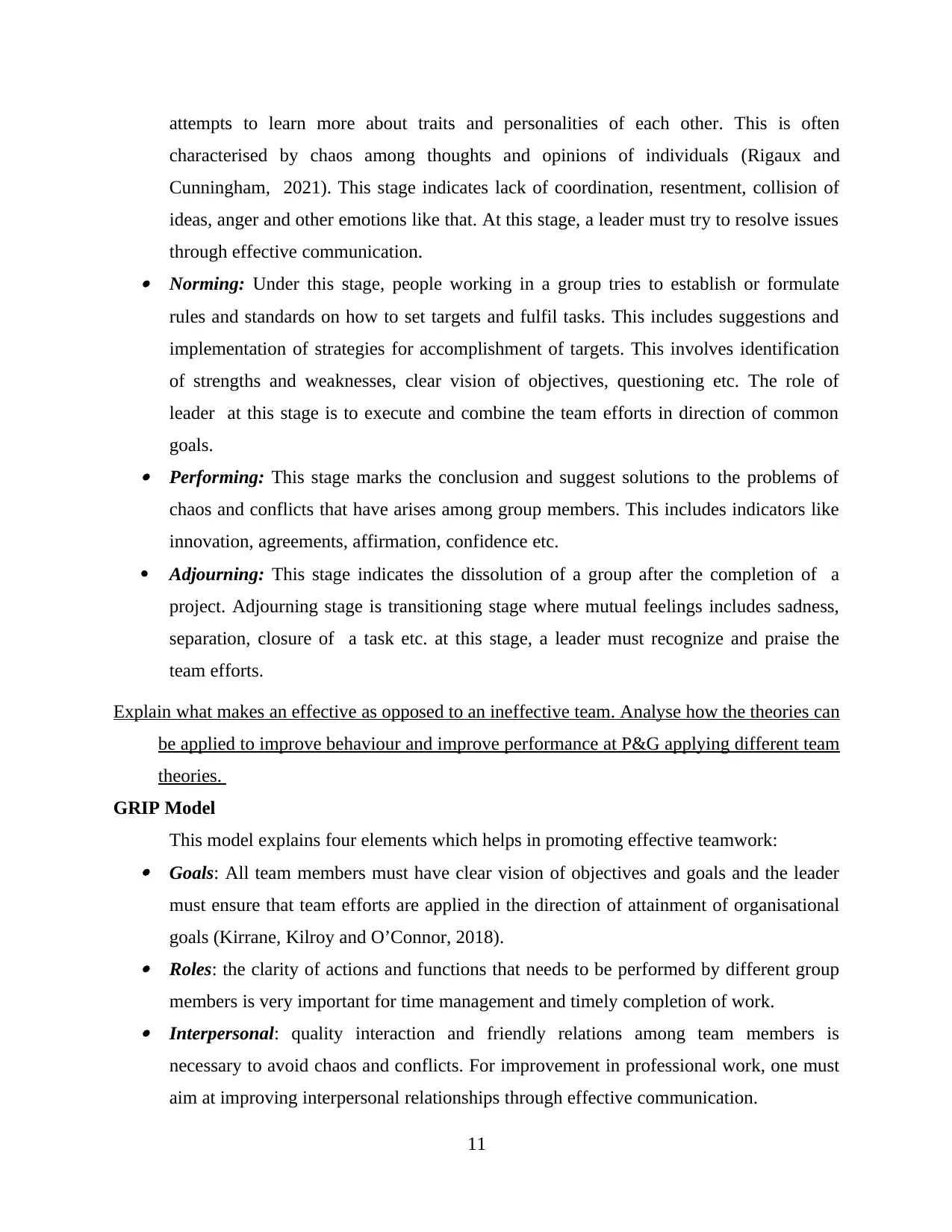
attempts to learn more about traits and personalities of each other. This is often
characterised by chaos among thoughts and opinions of individuals (Rigaux and
Cunningham, 2021). This stage indicates lack of coordination, resentment, collision of
ideas, anger and other emotions like that. At this stage, a leader must try to resolve issues
through effective communication. Norming: Under this stage, people working in a group tries to establish or formulate
rules and standards on how to set targets and fulfil tasks. This includes suggestions and
implementation of strategies for accomplishment of targets. This involves identification
of strengths and weaknesses, clear vision of objectives, questioning etc. The role of
leader at this stage is to execute and combine the team efforts in direction of common
goals. Performing: This stage marks the conclusion and suggest solutions to the problems of
chaos and conflicts that have arises among group members. This includes indicators like
innovation, agreements, affirmation, confidence etc.
Adjourning: This stage indicates the dissolution of a group after the completion of a
project. Adjourning stage is transitioning stage where mutual feelings includes sadness,
separation, closure of a task etc. at this stage, a leader must recognize and praise the
team efforts.
Explain what makes an effective as opposed to an ineffective team. Analyse how the theories can
be applied to improve behaviour and improve performance at P&G applying different team
theories.
GRIP Model
This model explains four elements which helps in promoting effective teamwork: Goals: All team members must have clear vision of objectives and goals and the leader
must ensure that team efforts are applied in the direction of attainment of organisational
goals (Kirrane, Kilroy and O’Connor, 2018). Roles: the clarity of actions and functions that needs to be performed by different group
members is very important for time management and timely completion of work. Interpersonal: quality interaction and friendly relations among team members is
necessary to avoid chaos and conflicts. For improvement in professional work, one must
aim at improving interpersonal relationships through effective communication.
11
characterised by chaos among thoughts and opinions of individuals (Rigaux and
Cunningham, 2021). This stage indicates lack of coordination, resentment, collision of
ideas, anger and other emotions like that. At this stage, a leader must try to resolve issues
through effective communication. Norming: Under this stage, people working in a group tries to establish or formulate
rules and standards on how to set targets and fulfil tasks. This includes suggestions and
implementation of strategies for accomplishment of targets. This involves identification
of strengths and weaknesses, clear vision of objectives, questioning etc. The role of
leader at this stage is to execute and combine the team efforts in direction of common
goals. Performing: This stage marks the conclusion and suggest solutions to the problems of
chaos and conflicts that have arises among group members. This includes indicators like
innovation, agreements, affirmation, confidence etc.
Adjourning: This stage indicates the dissolution of a group after the completion of a
project. Adjourning stage is transitioning stage where mutual feelings includes sadness,
separation, closure of a task etc. at this stage, a leader must recognize and praise the
team efforts.
Explain what makes an effective as opposed to an ineffective team. Analyse how the theories can
be applied to improve behaviour and improve performance at P&G applying different team
theories.
GRIP Model
This model explains four elements which helps in promoting effective teamwork: Goals: All team members must have clear vision of objectives and goals and the leader
must ensure that team efforts are applied in the direction of attainment of organisational
goals (Kirrane, Kilroy and O’Connor, 2018). Roles: the clarity of actions and functions that needs to be performed by different group
members is very important for time management and timely completion of work. Interpersonal: quality interaction and friendly relations among team members is
necessary to avoid chaos and conflicts. For improvement in professional work, one must
aim at improving interpersonal relationships through effective communication.
11
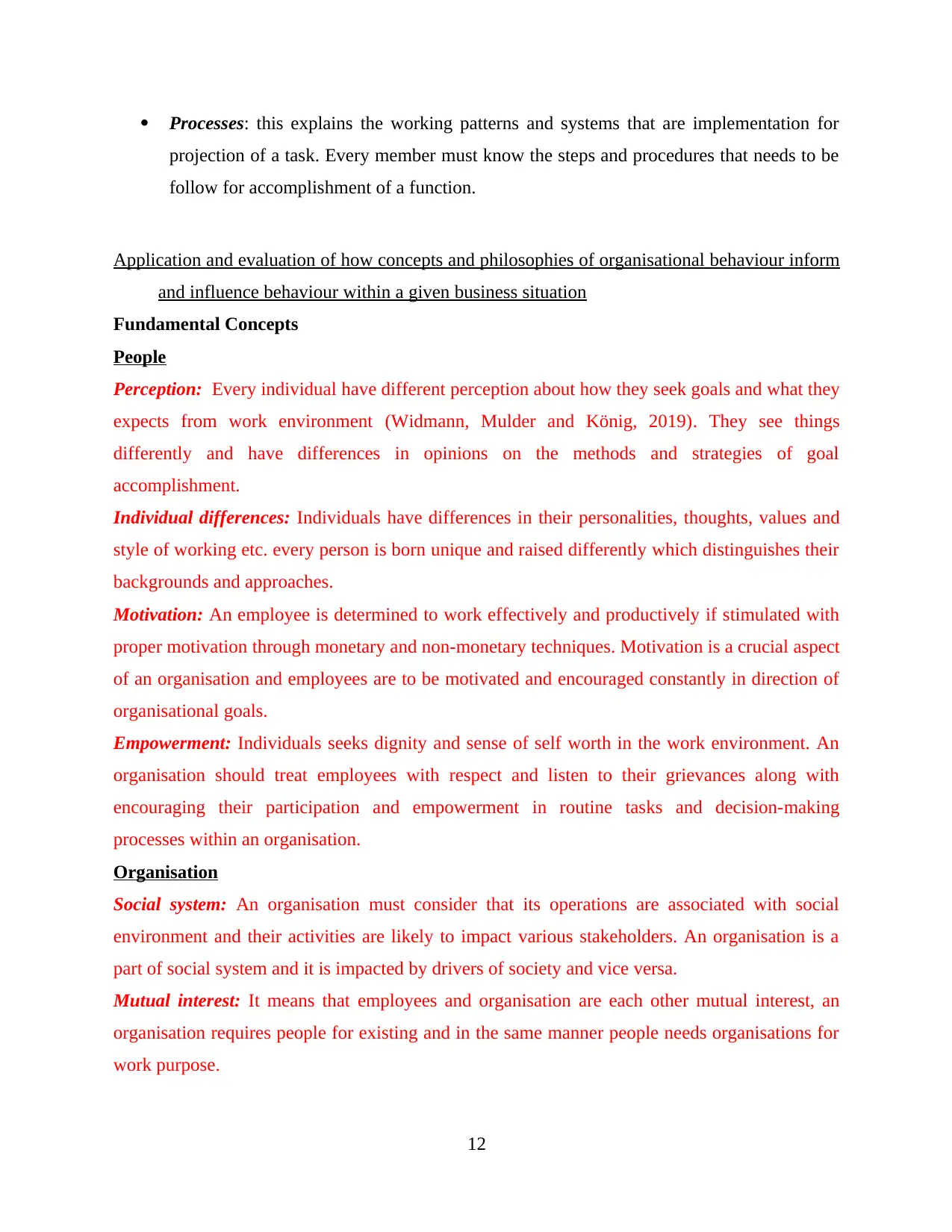
Processes: this explains the working patterns and systems that are implementation for
projection of a task. Every member must know the steps and procedures that needs to be
follow for accomplishment of a function.
Application and evaluation of how concepts and philosophies of organisational behaviour inform
and influence behaviour within a given business situation
Fundamental Concepts
People
Perception: Every individual have different perception about how they seek goals and what they
expects from work environment (Widmann, Mulder and König, 2019). They see things
differently and have differences in opinions on the methods and strategies of goal
accomplishment.
Individual differences: Individuals have differences in their personalities, thoughts, values and
style of working etc. every person is born unique and raised differently which distinguishes their
backgrounds and approaches.
Motivation: An employee is determined to work effectively and productively if stimulated with
proper motivation through monetary and non-monetary techniques. Motivation is a crucial aspect
of an organisation and employees are to be motivated and encouraged constantly in direction of
organisational goals.
Empowerment: Individuals seeks dignity and sense of self worth in the work environment. An
organisation should treat employees with respect and listen to their grievances along with
encouraging their participation and empowerment in routine tasks and decision-making
processes within an organisation.
Organisation
Social system: An organisation must consider that its operations are associated with social
environment and their activities are likely to impact various stakeholders. An organisation is a
part of social system and it is impacted by drivers of society and vice versa.
Mutual interest: It means that employees and organisation are each other mutual interest, an
organisation requires people for existing and in the same manner people needs organisations for
work purpose.
12
projection of a task. Every member must know the steps and procedures that needs to be
follow for accomplishment of a function.
Application and evaluation of how concepts and philosophies of organisational behaviour inform
and influence behaviour within a given business situation
Fundamental Concepts
People
Perception: Every individual have different perception about how they seek goals and what they
expects from work environment (Widmann, Mulder and König, 2019). They see things
differently and have differences in opinions on the methods and strategies of goal
accomplishment.
Individual differences: Individuals have differences in their personalities, thoughts, values and
style of working etc. every person is born unique and raised differently which distinguishes their
backgrounds and approaches.
Motivation: An employee is determined to work effectively and productively if stimulated with
proper motivation through monetary and non-monetary techniques. Motivation is a crucial aspect
of an organisation and employees are to be motivated and encouraged constantly in direction of
organisational goals.
Empowerment: Individuals seeks dignity and sense of self worth in the work environment. An
organisation should treat employees with respect and listen to their grievances along with
encouraging their participation and empowerment in routine tasks and decision-making
processes within an organisation.
Organisation
Social system: An organisation must consider that its operations are associated with social
environment and their activities are likely to impact various stakeholders. An organisation is a
part of social system and it is impacted by drivers of society and vice versa.
Mutual interest: It means that employees and organisation are each other mutual interest, an
organisation requires people for existing and in the same manner people needs organisations for
work purpose.
12
⊘ This is a preview!⊘
Do you want full access?
Subscribe today to unlock all pages.

Trusted by 1+ million students worldwide
1 out of 16
Related Documents
Your All-in-One AI-Powered Toolkit for Academic Success.
+13062052269
info@desklib.com
Available 24*7 on WhatsApp / Email
![[object Object]](/_next/static/media/star-bottom.7253800d.svg)
Unlock your academic potential
Copyright © 2020–2025 A2Z Services. All Rights Reserved. Developed and managed by ZUCOL.




